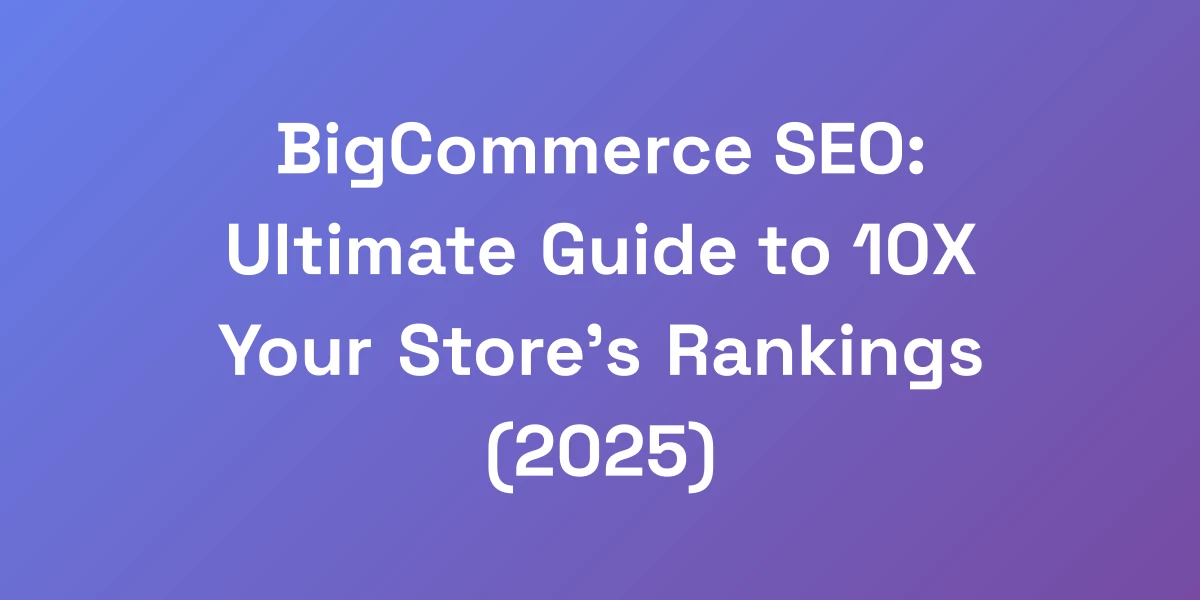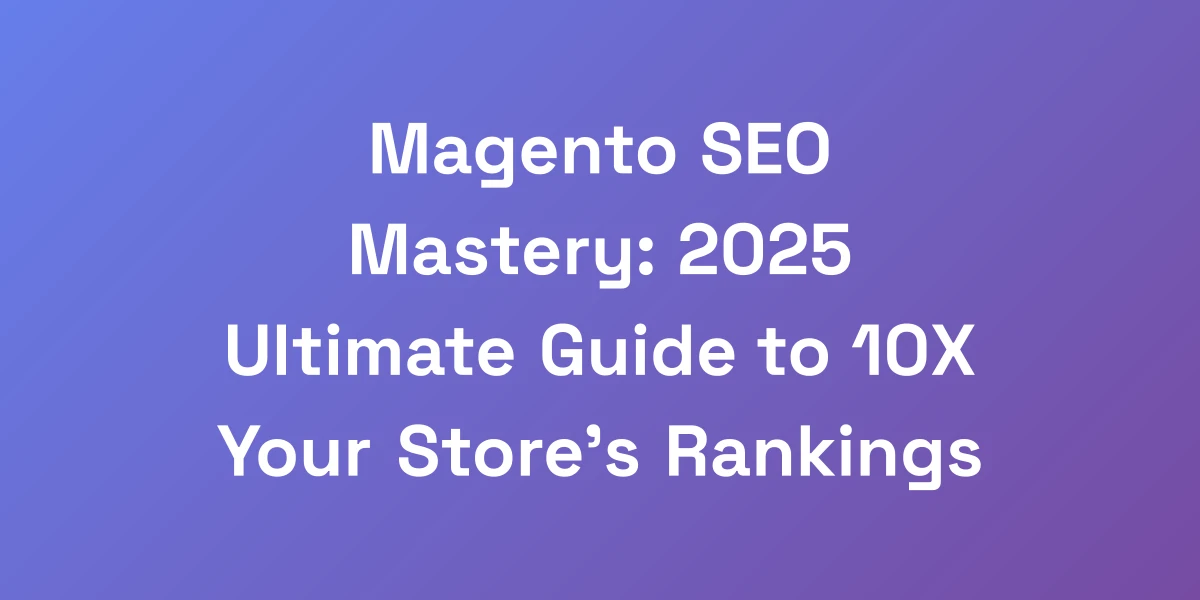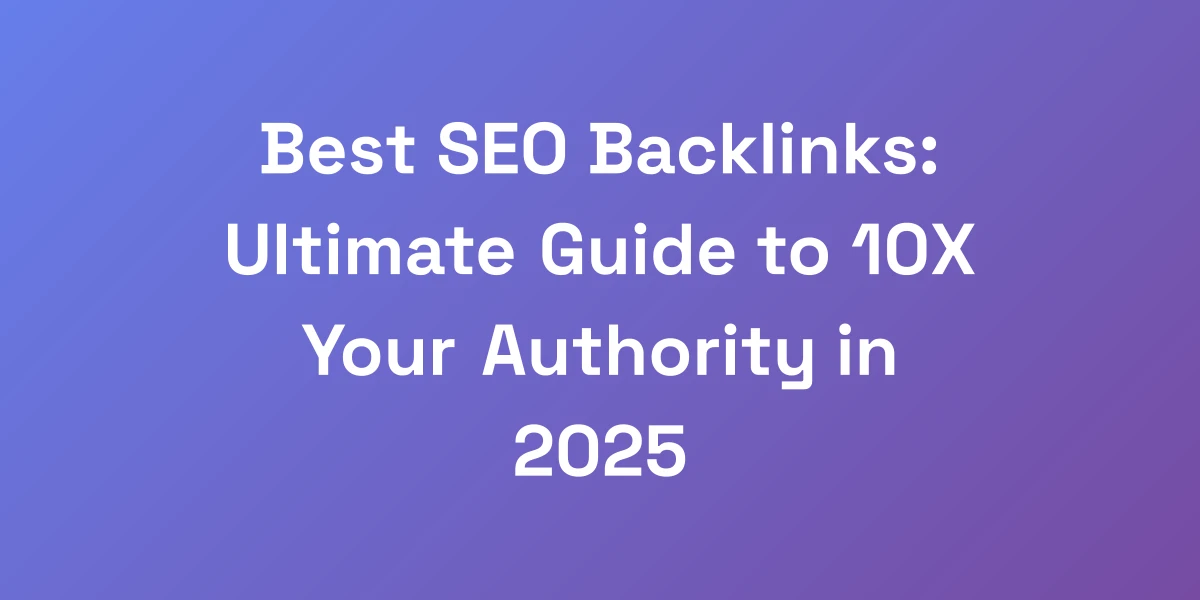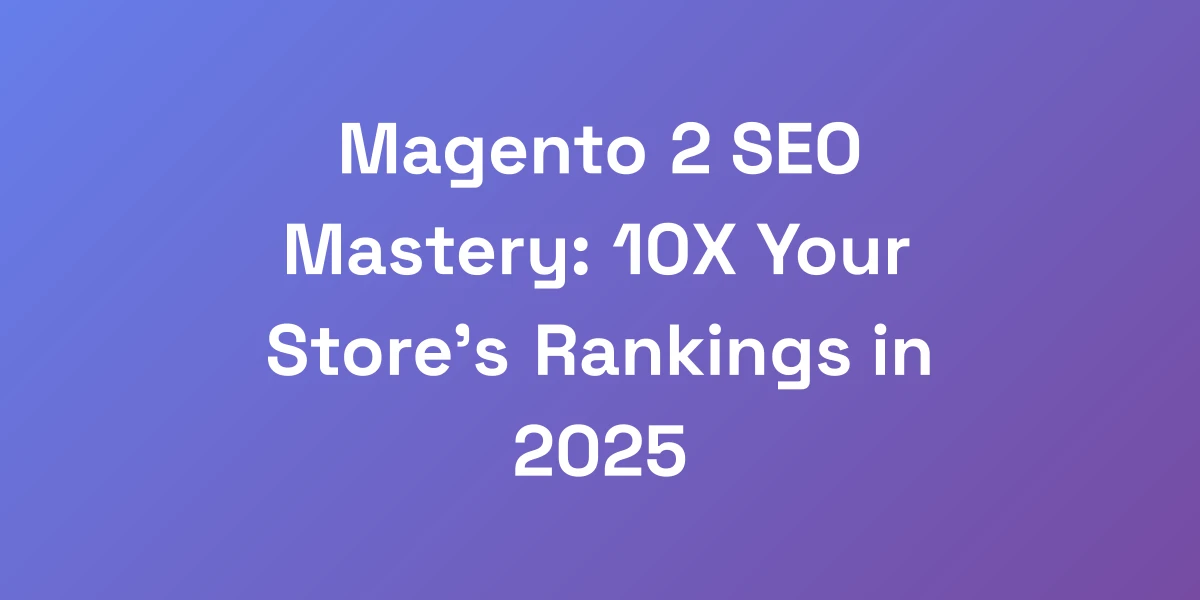
Ultimate Ecommerce SEO Package Guide: 10X Your Store’s Growth in 2025
Mar 12, 2025 | By [email protected]
Introduction
We’re cutting through the noise today because it’s time to get real about ecommerce SEO packages.
Imagine pouring your hard-earned money into an SEO package that promises the moon but delivers dust. Frustrating, right?
The ecommerce landscape is ruthless, and without the right SEO strategy, growth remains a distant dream.
But here’s the kicker: most of what’s being offered out there is outdated, ineffective, and frankly, a waste of your resources.
What you need isn’t another generic package—it’s a strategic, data-driven approach that aligns with your revenue goals.
In this guide, we’re diving deep into what makes an ecommerce SEO package truly powerful and how you can leverage it to 10X your store’s growth by 2025.
Ready to transform your ecommerce game? Let’s get started.
Why Most Ecommerce SEO Packages Fail to Deliver Results
Let’s be blunt: 90% of ecommerce SEO packages out there are total disappointments.
They promise skyrocketing traffic and booming sales but end up delivering minimal results.
Here’s why most fall short and how you can avoid falling into the same trap.
Common Red Flags in SEO Package Offerings
First off, watch out for SEO packages that rely on outdated tactics.
If an agency is still using strategies from 2015, it’s time to run.
- Keyword Stuffing: Overloading content with keywords is a sure sign of old-school SEO gone wrong.
- Generic Link Building: Low-quality backlinks from irrelevant sites won’t help your ecommerce store.
- One-Size-Fits-All Approach: Every ecommerce business is unique; cookie-cutter solutions just don’t cut it.
These tactics may have worked once, but the SEO landscape has evolved—and so should your approach.
The Real Cost of Choosing the Wrong Package
Opting for the wrong SEO package isn’t just a financial misstep—it can cripple your growth trajectory.
Consider the opportunity cost: money spent on ineffective strategies is money not invested in what truly drives revenue.
- Wasted Budget: Funds allocated to poor SEO efforts could be better spent on proven strategies.
- Lost Time: Time is money, and slow results mean lost opportunities to scale.
- Damaged Reputation: Poor SEO can negatively impact user experience, deterring potential customers.
In essence, the real cost isn’t just the money—it’s the lost potential.
Why Traditional SEO Metrics Don’t Matter for Ecommerce
Traditional SEO focuses on metrics like page views and keyword rankings.
But for ecommerce, these metrics don’t directly translate to revenue.
- Page Views vs. Conversions: Increased traffic is meaningless without converting visitors into buyers.
- Keyword Rankings vs. Purchase Intent: Ranking high for generic keywords doesn’t capture the intent of your target customers.
- Vanity Metrics: Numbers that look good on paper but don’t impact your bottom line.
What matters is how SEO efforts translate into actual sales and revenue growth.
The Revenue-First Approach to SEO
Here’s the game-changer: a revenue-first approach to ecommerce SEO.
Instead of chasing rankings, we focus on revenue-generating keywords and optimizing for conversions.
- Targeted Keywords: Identify and prioritize keywords that drive sales, not just traffic.
- Conversion Optimization: Enhance user experience to turn visitors into buyers seamlessly.
- Data-Driven Strategies: Use actionable insights and analytics to inform every decision, leveraging AI-powered SEO automation.
This approach ensures that every SEO effort is directly contributing to your store’s bottom line.
Case Study: How We 10X’d an Ecommerce Store’s Revenue
Let us share a success story to illustrate the power of the right SEO package.
We partnered with an ecommerce store struggling with stagnant traffic and declining sales.
Instead of generic strategies, we implemented a tailored, revenue-focused SEO plan.
- Keyword Overhaul: Shifted focus to high-intent, revenue-driving keywords.
- Technical Enhancements: Improved site speed and mobile responsiveness.
- Content Revamp: Created compelling product descriptions and optimized category pages.
Within a year, their revenue skyrocketed by 10X. Traffic increased by 150%, but more importantly, conversion rates doubled.
This is the difference between following the crowd and executing a strategic, revenue-first SEO plan.
Essential Components of a High-Converting Ecommerce SEO Package
Forget vanity metrics. A truly effective ecommerce SEO package is built on three core pillars: technical excellence, conversion optimization, and content that sells.
Having generated over $100M in ecommerce sales, we know integration is key.
You need a package that marries advanced technical SEO with proven conversion frameworks.
Here’s a breakdown of the exact components that differentiate a 6-figure store from a 7-figure powerhouse.
Technical SEO Infrastructure Requirements
At the foundation lies a robust technical SEO infrastructure.
This ensures that search engines can crawl and index your site efficiently, while users enjoy a seamless experience.
- Site Architecture: Logical, user-friendly structure that aids navigation and indexing.
- Mobile Optimization: With 72.9% of ecommerce sales expected on mobile in 2024, responsiveness is non-negotiable.
- Site Speed: Pages should load in under 3 seconds to prevent user drop-off.
Without these technical basics, even the best content and marketing efforts will falter.
Product Page Optimization Framework
Your product pages are the heart of your ecommerce store.
Optimizing them effectively can skyrocket your conversion rates.
- Keyword-Rich Descriptions: Craft compelling descriptions that incorporate targeted keywords naturally.
- High-Quality Images: Use clear, attractive images with proper alt text.
- Customer Reviews: Display authentic reviews to build trust and credibility.
Each element should work together to not only attract visitors but also convince them to make a purchase.
Category Page Architecture
Category pages guide users through your product offerings.
A well-structured category page enhances navigation and improves SEO.
- Clear Hierarchy: Organize categories logically to aid user navigation and search engine understanding.
- Optimized Titles and Meta Descriptions: Ensure each category has unique, keyword-optimized titles and meta descriptions.
- Internal Linking: Strategically link related products and categories to boost crawlability and SEO.
Effective category architecture not only improves user experience but also enhances search engine rankings.
Internal Linking Strategy
Internal linking is a cornerstone of SEO that’s often overlooked.
- Boost SEO Value: Distribute link equity throughout your site to improve the ranking of important pages.
- Enhance User Navigation: Help users find related products and content easily, reducing bounce rates.
- Keyword Optimization: Use descriptive anchor texts that signal relevance to search engines.
A strategic internal linking plan ensures that both users and search engines can navigate your site effortlessly.
Schema Markup Implementation
Schema markup is a powerful tool for enhancing your site’s visibility in search results.
It helps search engines understand your content better, leading to rich snippets and higher click-through rates.
- Product Schema: Includes product details like name, image, price, and reviews.
- Breadcrumb Schema: Enhances site structure visibility, aiding both users and search engines.
- Implementation Tools: Utilize Google’s Structured Data Markup Helper or CMS plugins for seamless integration.
Proper implementation of schema markup can significantly improve your search engine listings, making your products stand out.
Site Speed Optimization Protocol
Site speed isn’t just a ranking factor; it’s a critical component of user experience.
Slow-loading pages lead to higher bounce rates and lost sales.
- Optimize Images: Compress images without sacrificing quality to reduce load times.
- Leverage Browser Caching: Store static files locally to speed up page loads for returning visitors.
- Minimize HTTP Requests: Reduce the number of elements on your page to speed up rendering.
By adhering to a rigorous site speed optimization protocol, you ensure that customers stay longer and convert more.
Pricing Models That Actually Make Sense for Your Business
Here’s what most don’t tell you: ecommerce SEO pricing should align with your potential ROI, not arbitrary monthly retainers.
If you’re doing $100K/month in revenue, you need an SEO investment that propels you toward $1M/month without bleeding cash.
Let us show you how to structure your SEO investment for maximum returns.
ROI-Based Package Selection
Choose SEO packages based on the expected ROI rather than base pricing.
- Performance Metrics: Look for packages that tie costs to performance outcomes like revenue growth.
- Customized Solutions: Ensure the package is tailored to your specific revenue goals and market challenges.
- Transparent Reporting: Opt for providers that offer clear, data-driven reporting on ROI.
By focusing on ROI, you ensure that every dollar spent is a dollar working toward your growth, similar to SEO freelancing approaches.
Monthly vs. Performance-Based Pricing
There are two main pricing models: monthly retainers and performance-based pricing.
Each has its pros and cons, but performance-based pricing often offers better alignment with your growth goals.
- Monthly Retainers: Predictable costs but may not align with actual performance.
- Performance-Based: Costs are tied to achieving specific results, ensuring accountability.
Choosing the right model depends on your business goals and comfort with variable costs.
Budget Allocation Strategy
Effective budget allocation is critical for maximizing your SEO investment.
- Prioritize High-Impact Areas: Focus on technical SEO and conversion optimization first.
- Allocate for Content Creation: Invest in quality content that drives engagement and conversions.
- Reserve Funds for Advanced Strategies: Set aside budget for AI-driven optimizations and advanced analytics.
A strategic budget allocation ensures that your resources are used where they have the most significant impact.
Hidden Costs to Watch Out For
Be wary of hidden costs that can inflate your SEO budget unexpectedly.
- Setup Fees: Initial setup costs not included in the monthly pricing.
- Additional Content Requirements: Extra charges for content creation beyond the agreed scope.
- Tool Subscriptions: Costs for SEO tools and software that may not be covered in the package.
Always read the fine print and clarify all potential costs upfront to avoid surprises.
Scaling Your SEO Investment
As your ecommerce store grows, so should your SEO investment.
- Incremental Budgets: Gradually increase your SEO budget in line with revenue growth.
- Advanced Services: Incorporate more sophisticated SEO services as your needs evolve.
- Continuous Optimization: Regularly refine your strategies based on performance data.
Scaling your investment ensures that your SEO efforts grow in tandem with your business, maintaining momentum and driving sustained growth, similar to SEO strategies for startups.
When to Upgrade Your Package
Recognizing the right time to upgrade your SEO package can propel your business to new heights.
- Consistent ROI: When your current package consistently delivers ROI, it’s time to scale.
- Expanded Services: If you need additional services like advanced analytics or AI optimization, consider upgrading.
- Business Growth: As your ecommerce store scales, your SEO needs become more complex and demand a higher-tier package.
Upgrading at the right time ensures that your SEO strategies evolve alongside your business, continually driving growth.
Implementation Timeline and Expected Results
Let’s cut through the BS: SEO isn’t magic, and anyone promising overnight results is lying to you.
But with the right package and implementation strategy, significant improvements can be seen within 90 days.
Based on data from over 500 ecommerce sites, here’s a realistic roadmap to achievable, measurable results with your SEO investment.
30-Day Quick Wins
The first month is all about laying the groundwork and making immediate improvements.
- Technical Audit: Identify and fix critical technical issues like broken links and site speed problems.
- Keyword Research: Focus on high-intent keywords that drive conversions.
- On-Page Optimization: Optimize key product and category pages for targeted keywords.
These quick wins set the stage for sustained growth by addressing the most pressing issues upfront.
90-Day Growth Milestones
By the third month, your efforts start to bear fruit.
- Content Development: Publish high-quality, keyword-optimized content that attracts and engages visitors.
- Link Building: Begin building high-quality backlinks to improve domain authority.
- Conversion Rate Optimization: Implement strategies to enhance user experience and increase conversions.
At this stage, you should start seeing an uptick in organic traffic and initial improvements in rankings.
6-Month Success Markers
Half a year in, your SEO strategies should be well-integrated and driving substantial growth.
- Significant Traffic Increase: Expect a marked increase in organic traffic as your content and link-building efforts pay off.
- Improved Rankings: Higher rankings for targeted keywords lead to more visibility and traffic.
- Enhanced User Engagement: Better user experience results in longer session durations and lower bounce rates.
Your ecommerce store should be experiencing noticeable growth in both traffic and sales.
Year-One Transformation Goals
One year down the line, your SEO efforts should have transformed your ecommerce store.
- Dominant Search Presence: Achieve top rankings for a majority of your high-intent keywords.
- Strong Backlink Profile: A robust network of high-quality backlinks driving authority and traffic.
- Sustained Revenue Growth: Consistent increases in sales and revenue, aligning with your 10X growth target.
By this point, SEO should be a well-oiled machine driving sustained growth and revenue for your store.
Tracking and Reporting Systems
Effective tracking and reporting are crucial for measuring the success of your SEO efforts.
- Analytics Tools: Utilize tools like Google Analytics and SEMrush to monitor performance.
- Regular Reporting: Weekly and monthly reports keep you informed about progress and areas needing improvement.
- KPIs Tracking: Focus on key performance indicators like organic traffic, conversion rates, and ROI.
Consistent tracking ensures that you stay on course and can adjust strategies as needed to meet your goals.
ROI Measurement Framework
Measuring ROI is essential to understanding the effectiveness of your SEO strategies.
- Define Clear Goals: Establish what success looks like, whether it’s increased sales, traffic, or conversions.
- Calculate ROI: Compare the revenue generated from SEO efforts against the investment made.
- Adjust Strategies: Use ROI data to refine and optimize your SEO tactics for better results.
An effective ROI measurement framework ensures that your SEO investment is driving real, tangible results.
Advanced Optimization Strategies Most Packages Don’t Include
Want to know what separates 7-figure stores from the rest? It’s the advanced optimization strategies that 99% of SEO packages ignore.
We’re talking about AI-driven content optimization, predictive search intent mapping, and dynamic product clustering.
These aren’t just fancy terms—they’re proven revenue generators that can double or triple your organic traffic conversion rates.
AI-Powered Keyword Research
Traditional keyword research is time-consuming and often incomplete.
AI-powered tools analyze vast datasets to uncover high-intent keywords that drive conversions.
- Predictive Analysis: Anticipate trending keywords before they become saturated.
- Semantic Understanding: Identify related terms and phrases that enhance content relevance.
- Efficiency: Automate the research process to save time and resources.
Leveraging AI for keyword research ensures you’re always ahead of the curve, capturing traffic before your competitors even notice.
Competitor Gap Analysis
Understanding your competitors is crucial for staying ahead.
Competitor gap analysis identifies opportunities where your competitors are falling short, allowing you to capitalize on their weaknesses.
- Identify Weaknesses: Pinpoint areas where competitors lack depth or quality.
- Opportunity Mapping: Discover untapped keywords and content opportunities.
- Strategic Positioning: Position your products and content to fill the gaps left by competitors.
This strategy ensures that your ecommerce store is always a step ahead, capturing market share from competitors who are stuck in the past.
User Intent Mapping
Understanding user intent is key to driving conversions.
User intent mapping aligns your SEO strategies with what your customers are actually looking for.
- Intent Categorization: Classify search queries based on informational, navigational, transactional, and commercial intent.
- Content Alignment: Create content that specifically addresses the needs and intentions of your target audience.
- Enhanced Relevance: Ensure that your content is directly relevant to the search intent, boosting engagement and conversions.
By aligning your SEO efforts with user intent, you ensure that your ecommerce store meets the exact needs of your customers, driving higher conversions.
Dynamic Product Optimization
Static product pages are a thing of the past.
Dynamic product optimization uses real-time data to tailor product listings to individual user preferences and behaviors.
- Personalized Content: Display product information and recommendations based on user behavior and preferences.
- A/B Testing: Continuously test different elements of your product pages to find what converts best.
- Real-Time Updates: Adjust product listings based on current trends and user interactions.
Dynamic optimization ensures that your product pages are always relevant and compelling, maximizing the chances of conversion.
Advanced Analytics Integration
Data is the backbone of effective SEO strategies.
Advanced analytics integration goes beyond basic metrics, providing deep insights into user behavior and campaign performance.
- Behavioral Tracking: Understand how users interact with your site, identifying drop-off points and areas for improvement.
- Predictive Analytics: Forecast future trends and adjust your strategies proactively.
- Comprehensive Dashboards: Centralize all your data in one place for easy analysis and decision-making.
With advanced analytics, you gain a comprehensive understanding of your SEO performance, allowing for continuous optimization and growth.
Conversion Rate Optimization Tactics
Driving traffic is only half the battle; converting that traffic into sales is where the real victory lies.
Effective conversion rate optimization (CRO) tactics ensure that your ecommerce store not only attracts visitors but also turns them into loyal customers.
- Clear CTAs: Craft compelling calls-to-action that guide users towards making a purchase.
- Streamlined Checkout Process: Simplify the checkout process to reduce cart abandonment rates.
- Trust Signals: Incorporate elements like secure payment badges and customer reviews to build trust.
By integrating CRO tactics into your SEO strategy, you maximize the value of your traffic and drive higher sales.
Conclusion
We’ve navigated through the murky waters of ecommerce SEO, uncovering the truths that most packages hide.
From recognizing why most fails to understanding the essential components and advanced strategies, you’re now equipped to make informed decisions.
The key takeaway? A strategic, revenue-first SEO package tailored to your unique ecommerce needs is the only way to achieve explosive growth.
Ready to take the next step? Evaluate your current SEO strategy against this guide and identify the gaps.
Don’t settle for mediocre results. Invest in a comprehensive, data-driven SEO package that’s designed to 10X your store’s growth by 2025.
Have questions or need personalized advice? Drop a comment below or reach out to us directly.
Let’s achieve extraordinary growth together.








